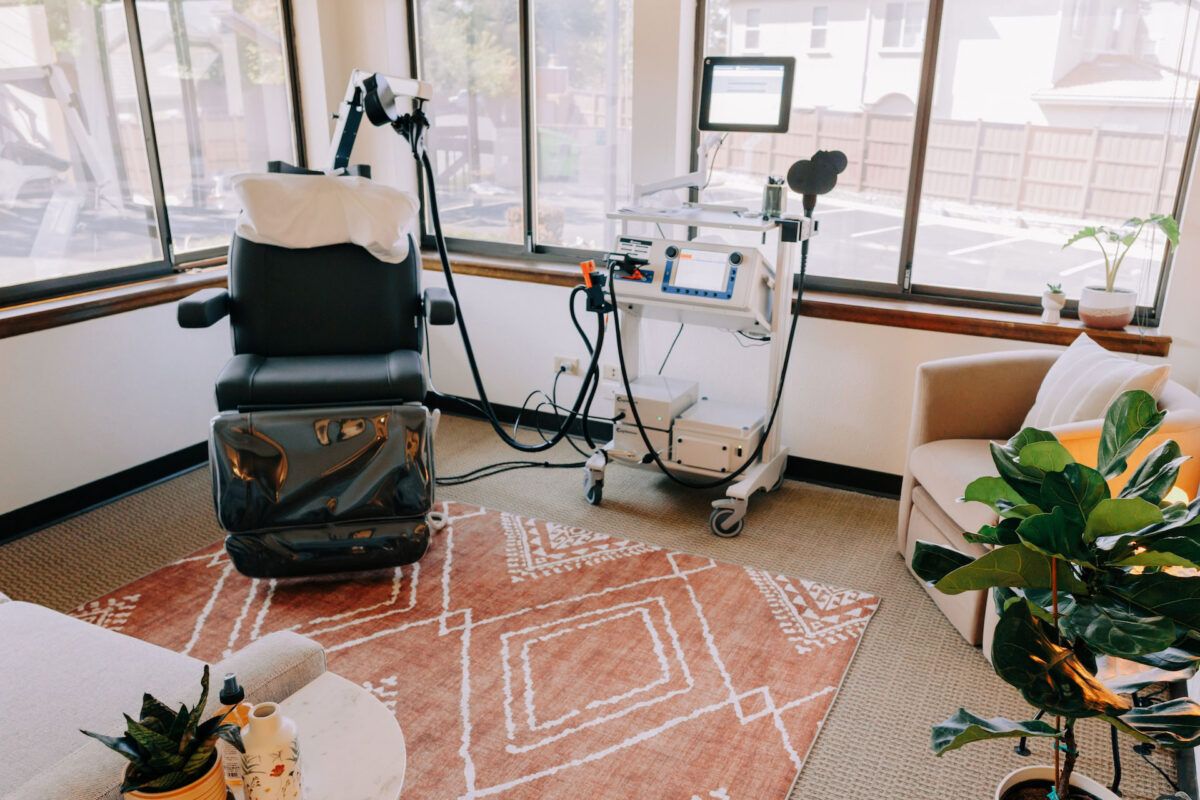Transcranial Magnetic Stimulation (TMS) is a non-invasive, FDA-cleared treatment for depression and other mental health conditions. Unlike medications, TMS targets specific areas of the brain involved in mood regulation, helping patients find relief without systemic side effects.
TMS uses focused magnetic pulses to stimulate brain regions, promoting healthy neural activity. Treatments are safe, outpatient-based, and typically involve little to no downtime.
TMS Options
Accelerated TMS (aTMS)
-
- Schedule: Multiple sessions per day over 1–5 days
-
- Benefits:
-
- Fast symptom relief
-
- Minimal disruption to daily life
-
- Low risk of side effects
-
- Benefits:
-
- Considerations:
-
- Protocols are newer and still being studied
-
- Considerations:
Traditional TMS
-
- Schedule: 1 session/day, 5 days/week, for 4–6 weeks
-
- Benefits:
-
- Well-established safety and effectiveness
-
- FDA-cleared for treatment-resistant depression
-
- Benefits:
-
- Considerations:
-
- Requires multi-week commitment
-
- Symptom improvement occurs more gradually
-
- Considerations:
Antidepressant Medications
-
- Schedule: Daily oral medications (SSRIs, SNRIs, etc.)
-
- Benefits:
-
- Widely available and often covered by insurance
-
- Frequently first-line treatment
-
- Benefits:
-
- Considerations:
-
- Side effects: weight gain, sleep changes, sexual dysfunction
-
- May take several weeks to work
-
- About one-third of patients develop treatment-resistant depression
-
- Considerations:
Comparing TMS and Medications
| Treatment | Duration | Key Benefits | Limitations |
|---|---|---|---|
| Accelerated TMS | 1–5 days | Rapid relief, low side effects | Newer protocols, long-term data still emerging |
| Traditional TMS | 4–6 weeks | FDA-cleared, non-invasive | Longer time commitment, slower results |
| Antidepressants | Daily | Accessible, often insurance-covered | Side effects, slower onset, lower response in TRD |
Why Choose TMS?
-
- Safe & Non-Invasive: No anesthesia, no systemic side effects, minimal discomfort
-
- Effective: Works even when medications have failed
-
- Flexible Options: Accelerated treatments allow for faster results, ideal for busy schedules or urgent needs
-
- Supports Ongoing Therapy: TMS can enhance the effectiveness of psychotherapy and other interventions
Who Can Benefit?
-
- Patients with Treatment-Resistant Depression: Even after multiple medication trials
-
- Professionals & Busy Adults: Accelerated schedules minimize time away from work
-
- Medication-Sensitive Patients: Avoid common side effects of antidepressants
-
- Supporters & Family: TMS provides hope and measurable improvement for loved ones struggling with depression
Conditions Treated
-
- Major Depressive Disorder (especially treatment-resistant)
-
- Obsessive-Compulsive Disorder (OCD)
-
- Post-Traumatic Stress Disorder (PTSD)
-
- Bipolar Depression
-
- Chronic Pain & Emerging Mental Health Applications
The Patient Journey
-
- Consultation: Assessment of symptoms, prior treatments, and goals
-
- Personalized Plan: Traditional or accelerated TMS based on needs
-
- Treatment: Outpatient sessions with minimal discomfort
-
- Follow-Up: Monitoring progress and adjusting care as needed
-
- Maintenance: Periodic sessions can help prevent relapse
Safety & Side Effects
- Most common: mild headache or scalp discomfort
- Rare risks: seizure (<0.1% with proper screening)
- No systemic medication effects, no weight gain, no cognitive dulling
- Safe for patients already on medications or with medical conditions (after evaluation)
Insurance & Coverage
TMS is increasingly covered by insurance. Our team at Zephyr Behavioral Health helps patients navigate authorizations and coverage to minimize out-of-pocket costs.
Rapid Relief When You Need It
Accelerated TMS is ideal for patients in urgent need of relief. Multiple sessions per day can produce improvements in just a few days, helping patients regain stability and return to daily life more quickly.


